Texas Roadhouse vs. LongHorn Steakhouse: Which Serves the Best Bone-In Ribeye?
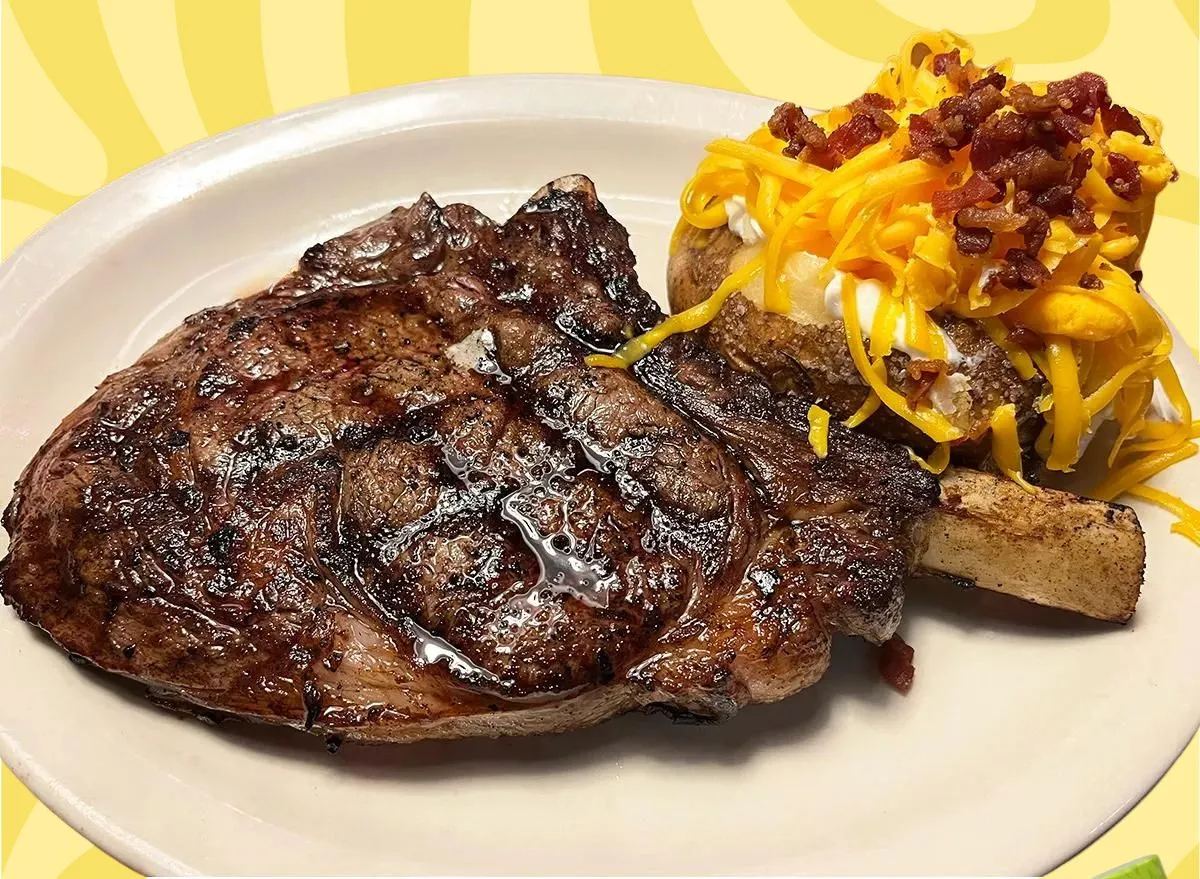
Of all the beefy cuts you can order at a steakhouse, the bone-in ribeye is perhaps the most primal pick. Sure, you can get other meats on the bone, too, like the classic T-bone, for instance. But there’s no boneless option with a T-bone. You can order a strip steak and a filet separately, but rarely on the same plate, not without that T-shaped bone in the middle.
The bone-in ribeye, on the other hand, is a distinctive choice. By selecting the bony option over a regular ol’ ribeye, you either desire the added flavor that extra appendage brings, or you want to feel like TV’s Fred Flintstone when that massive, skeletal hunk of meat arrives at your table. Or, maybe both.
Whatever your motivations, the bone-in ribeye is an increasingly popular cut served at steakhouses all across America, including all three of the nation’s largest chains: LongHorn Steakhouse, Outback Steakhouse, and Texas Roadhouse.
I previously carved up the bone-in ribeyes at Outback and Texas Roadhouse to see which chain serves the best one, so it’s only fair to now compare the victorious Texas Roadhouse version to LongHorn’s.
While both steakhouse chains share some similarities—each promoting a southwestern theme and serving USDA Choice-grade meats, with more affordable prices and a more casual atmosphere than certain other highfalutin meat temples—there are major differences as well.
For one thing, LongHorn is part of the Darden Restaurants behemoth, which also operates fancier steakhouse chains Capital Grille and Ruth’s Chris. So, if any company has the institutional wherewithal to go toe-to-toe with the insurgent Texas Roadhouse in the beef category, it’s that one.
Of course, bigger isn’t always better, so let’s see how each steakhouse fares where it matters most—on your plate.
LongHorn Steakhouse
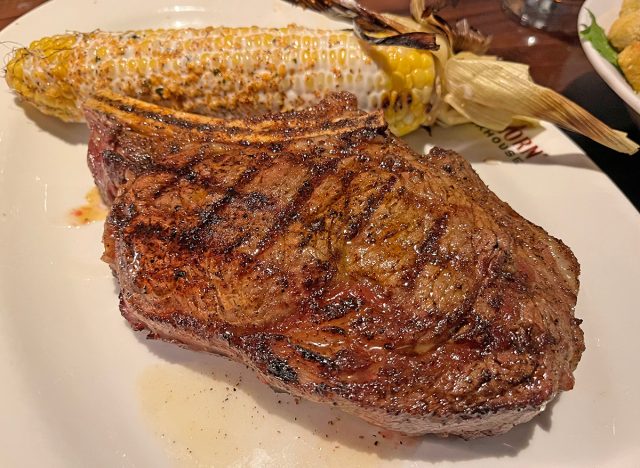
[n-black]Nutrition (Per Outlaw Ribeye, 20 oz):
Calories: 1250
Fat: 87 g (Saturated Fat: 38 g)
Sodium: 1670 mg
Carbs: 2 g (Fiber: 0 g, Sugar: 0 g)
Protein: 94 g[/nutrinfo-black]
At LongHorn, the 20-ounce bone-in cut is called the Outlaw Ribeye. “Not trying it would be a crime!” according to the menu. During dinner, this hulking steak comes with two sides, costing me $32.99 in Elmhurst, N.Y., but you can get it at lunchtime with a single side for a few bucks less at $29.99. Ordered medium rare, this steak measured about an inch-and-a-half thick and weighed in at 18.7 ounces after cooking, according to my digital scale. It also came with a sleek, modishly silvery and scarily serrated steak knife that could easily fend-off muggers in a street fight.
The look: Massive, juicy, and nicely charred. The surface came covered with those checkerboard-patterned grate marks that you love to see from a freshly grilled steak, and it shimmered with moisture in the restaurant’s dim light. A curvy bone was clearly visible at the rear, stretching about four to five inches long. Inside the center struck a dark red color that seemed a little rarer than expected, which I personally don’t mind.
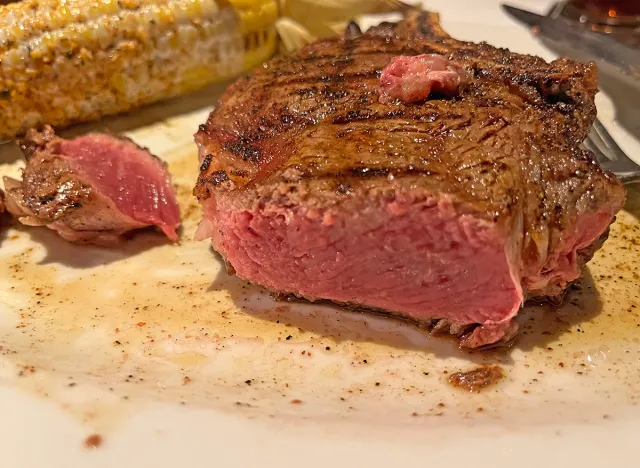
The taste: Rich, savory, and reasonably seasoned. Some LongHorn steaks are so heavily spiced that the true flavor of the meat gets lost in the deluge. Thankfully, this cut took a much lighter hit from the shaker, allowing more of that natural beefy goodness to shine through. Each bite carried strong smoky notes from the grill and showcased the tenderness that a well-marbled ribeye is known for, with gobs of soft, fast-dissolving fat throughout, particularly along the edges.
It took some time to cut through this considerable hunk of meat, but when I finally whittled down to only bone, the remaining shard weighed a whole ounce, translating to well over a full pound of meat and hinting at a very long nap ahead.
Texas Roadhouse
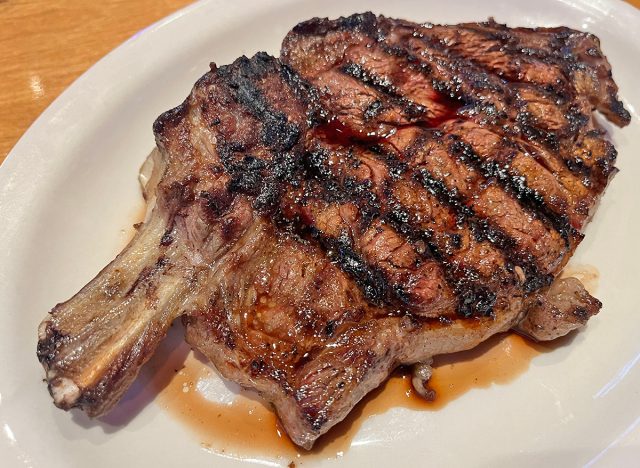
Calories: 1480
Fat: 101 g (Saturated Fat: 44 g)
Sodium: 1720 mg
Carbs: 20 g (Fiber: 4 g, Sugar: 4 g)
Protein: 143 g
The last time I tried to order this steak, my local roadhouse was all sold out, which just goes to underscore the popularity of this particular cut. In fact, my server suggested it’s the top-seller, at least in Teterboro, N.J. That’s the trick with steaks that are hand-cut daily, as Texas Roadhouse so proudly advertises—there’s not an unlimited supply on hand. The next time I visited, I made sure to arrive early enough to snag one. This 20-ounce bone-in ribeye cost me $29.99, a dollar more than I paid earlier this summer at a different location in Hagerstown, Md.
Like the LongHorn version, it came with my choice of two sides. Unlike the LongHorn version, it came with a clunky, wood-handled steak knife that looked like something you’d find at the liquidation auction of an old Sizzler. Of course, that’s part of charm of Texas Roadhouse: zero frills. When the meal arrived, my medium-rare steak sized-up a little smaller than its LongHorn counterpart: about an inch thick and weighing just under a pound at 15.97 ounces.
The look: Plump and succulent. Upon arrival, its hearty juices were already pooling underneath the meat, and the moisture up top reflected the striking blue glow of the star-shaped lighting fixture above the bar where I sat. Suffice it to say, it’s a very juicy steak, and its streaky char marks attested to a healthy stint over the flames. The conspicuous bone, meanwhile, jutted out like a little handlebar. Inside the meat took on a perfectly lush, red color.
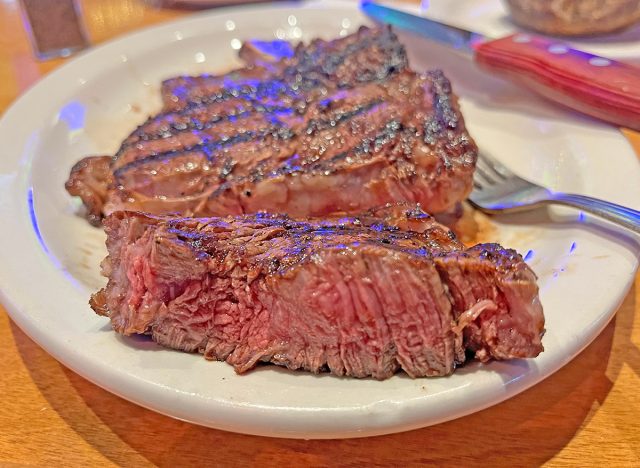
The taste: Just as mouthwatering as I remembered. Salty, savory, and super juicy, this steak was superbly seasoned, and every fatty bite felt so tender I hardly needed to chew. The entire steak was gone in a flash, leaving behind a substantial 2.7-ounce chunk of bone, which works out to just over 13 ounces of very delicious meat.
The Verdict
This matchup proved a lot closer than the prior contest. While the bone-in ribeye at Outback is the clear standout of all the steaks on that particular chain’s menu, it seemed much less impressive compared to its bigger, better-tasting rival at Texas Roadhouse. The bone-in ribeye at LongHorn, meanwhile, surpassed the Texas Roadhouse version in size, and it also seemed a more worthy adversary in the flavor department.
But, somehow Texas Roadhouse attains a higher level of juiciness and tenderness that neither Outback nor LongHorn can quite compete with, at least in my experience. And, as a bone-in bonus, its version will save you a few bucks, too.









